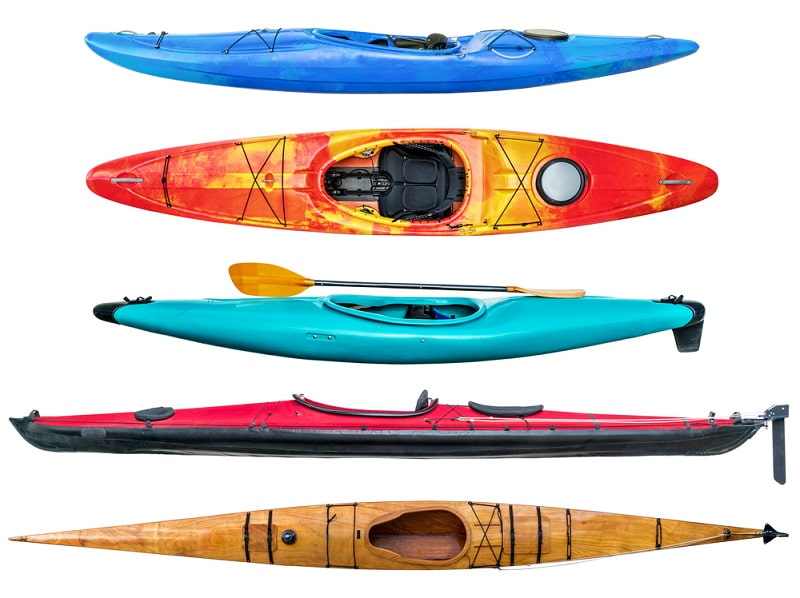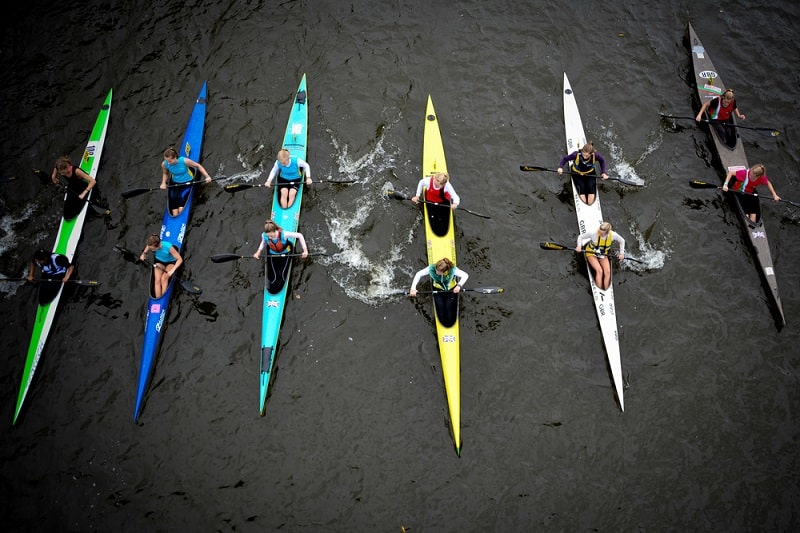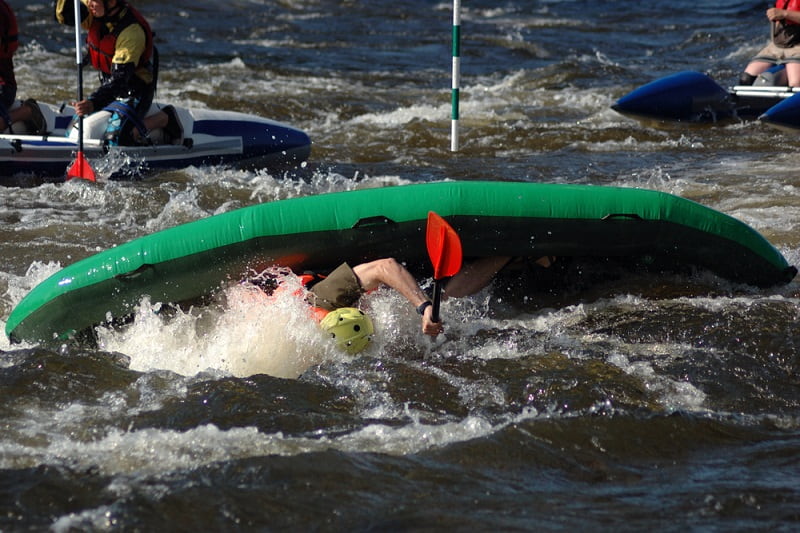You have a general idea of what rudders are used for, and you’re wondering if a rudder might benefit your kayak.
Do people even put rudders on inflatable kayaks? If so, how do you install one on yours? What are some common problems you may run into with using a rudder?
Let’s find out, shall we?
Table of Contents
What is a Rudder on an Inflatable Kayak?

A rudder is a long, vaguely fin-shaped piece of equipment used to turn a boat. The rudder is typically mounted to the transom on a kayak, and it can be raised out of the water when not in use.
The rudder system on a kayak shouldn’t be confused with the skeg. A kayak’s skeg moves up and down in the water, changing the boat’s center of resistance; it doesn’t move back and forth like a rudder does, and its purpose is entirely different.
A rudder has two main purposes when rigged to an inflatable kayak:
- To help steer and turn: As you move the rudder to the right, your boat will move toward the right; as you move it to the left, your boat will turn toward the left. Rudders can help you navigate through narrow spaces and make tight turns.
- To keep you moving straight: In choppy waters and rough weather conditions, using a rudder can help you keep a straight course, as moving it left or right will allow you to compensate for your boat drifting or being blown off-course.
There are several components of a rudder system:

- Fin or blade: The most recognizable part, the fin, or rudder blade, is the part that goes down into the water and turns to steer the boat.
- Hand or foot pedals: This is how you move the rudder. Some rudder systems have pedals that you operate with your feet, while others you can pull and release with your hands.
- Cables: The rudder blade and the hand or foot pedal are connected by heavy-duty cables. The cables move forward and backward to turn the rudder blade as you move the pedal.
- Lift lines: These are what you use to lift the rudder blade into and out of the water.
Most inflatable kayaks don’t come with a rudder system; you must purchase one separately. But do you even need a rudder system to begin with?
Is a Rudder Necessary for an Inflatable Kayak?

The short answer is no; if a rudder were necessary, it would have come with your kayak. That said, some people prefer to use a rudder and can benefit from its use.
Many experienced kayakers look down on the practice of using rudders. They prefer the challenge of steering entirely with a paddle.
This can, of course, be a more difficult technique to master, and many other kayakers find it easier to use a rudder system.
Whether or not you could benefit from a rudder may depend on the design of your kayak; not all kayaks will support a rudder system. This is especially true of inflatable kayaks, which may come with a removable skeg but can’t have a rudder system because there is no room.
Whether you want to use a rudder may depend on water conditions, as well as your own skill level. There may be times when you find that a rudder system is beneficial and other times when it isn’t.
So, you don’t need a rudder; but it can help make your job easier in several scenarios.
What scenarios, you ask? Let’s find out.
When to Use a Rudder?

- If you’re inexperienced: If you’re new to kayaking, you may find that having a rudder can help as you learn how to steer and navigate through the water. In these cases, having a rudder in place will offer support as you learn how to paddle.
- During stormy weather: When the weather is bad, the water may be rougher than normal. In these situations, having a rudder will help you move through the water more easily and effectively without getting blown off-course.
- On rough waters: If you like to test yourself on river rapids or other choppy, dangerous waters, a rudder will help you steer and keep you on track better than your paddle alone could do.
- On long trips: If you like to take extended outings in your kayak, having a rudder system will make your job easier, allowing you to save energy and effort over time.
- In kayak races: Rudders allow you to maneuver your kayak more easily and efficiently. This makes them a great addition to your kayak any time you enter a race, though you’ll want to make sure beforehand that there aren’t any regulations against using them.
How to Install a Rudder on an Inflatable Kayak?

Some kayaks have a hard plastic end tip on the stern; you can drill a hole in this end tip and mount your rudder there, following the instructions included with the rudder.
Many times, though, inflatable kayaks don’t have this end tip. It can be difficult to put a rudder on these inflatables because you can’t mount it directly to the kayak. You will have to rig a mount and secure it by means other than hardware.
That is what we’re going to talk about in this section.
First, check out the video below to get an idea for a DIY rudder mount, then follow the following steps:
- Use a heavy-duty cutting board or piece of smooth, treated wood. This will be your mount. You can cut angles in it to make it more triangular shaped, or you can leave it as-is.
- Drill holes in the cutting board, as shown in the pictures of this article.
- Bend a steel or heavy-duty aluminum ruler so it has a 90-degree angle. You may have to cut it down to size, about 16 inches. Secure the long side of the ruler to the cutting board and the short side to the rudder, mounting the rudder according to package directions.
- Strap down the mount to the kayak transom, as shown in the video. If necessary, glue some D-rings onto the transom, so you have something to strap the mount to.
- Mount D-rings on your kayak, near your seat or sitting area. One D-ring on each side will do.
- Run cables or control lines from the rudder to the D-rings and back. This way, you will simply have to pull on the left cable to turn left and on the right cable to turn right.
Common Problems with Rudders and How to Avoid Them
Let’s check out some common arguments against using rudders and discuss how to avoid running into these problems.
Rudders Break Easily

The most common concern about using a rudder is that it could break under stress the moment you depend on it the most.
If you’re relying on your rudder to help you win that race or get through those rapids, the last thing you want is for the blade to snap or the cables to break under the weight of the challenge.
There are plenty of cheap rudders on the market, so to avoid this problem, do your research beforehand. Read customer reviews. Don’t buy the cheapest option out there.
Look for a quality-made product with stainless-steel cables and a heavy-duty aluminum or stainless steel rudder. If you’re serious about having a rudder for extreme uses, it’s important to invest in a good one.
Rudders Make You Lazy

Many experienced kayakers look down on rudders and those who use them, saying they can make you lazy. After all, using a rudder makes your job easier and reduces your need to become proficient at paddling.
In other words, you could easily come to rely on your rudder rather than learning proper kayaking techniques.
To avoid this problem, become aware of it and resist the temptation to rely on your rudder all the time. Use it to support you as you learn the proper techniques, and sometimes force yourself to practice without the rudder.
There is no need to become lazy because you have a rudder. Rudders have many legitimate uses and can make your job easier, but you should never come to rely on them completely.
Rudders Can Cause Weathercocking
Weathercocking is the term used to describe what happens when your boat turns 90 degrees, perpendicular to the current–like a weathercock in the wind.
This can happen during extremely windy conditions when the wind catches your kayak just right. Though you might think a rudder would help you avoid weathercocking, it can make the problem worse.
The way to avoid this problem is to learn how to compensate for the wind direction and speed. You do this by adjusting the trim and shifting your weight in the kayak. Move your seat forward or backward until you’ve struck a balance that allows your rudder to steer regardless of the wind.
Finding this balance will probably take some trial and error, so it’s a good idea to avoid extremely rough wind and weather conditions until you’ve mastered the technique.
Conclusion
Rudders are not necessary for inflatable kayaks, but they can make your job easier and help you out in many situations.
If you’re starting out, use a rudder to help you steer while you learn the proper paddling techniques, but don’t allow yourself to become lazy and rely fully on the rudder.
The rudder has its place in kayaking, but it also has limitations and should not be depended on in every situation.

Sarah Hood has been writing for Anchor Travel since 2021. When she’s not writing, she enjoys cooking, singing, and spending time in the great outdoors.


